When they come across a Catholic custom they do not like or do not understand, Protestant Christians are likely to challenge Catholics with “Where is that in the Bible??”
One of the Catholic customs most dislike is the veneration of relics. In every consecrated Catholic altar, for example, there are placed relics of the saints. Our new church of Our Lady of the Rosary has a major reliquary with first class relics of a first century martyr, St Benedict, St Therese, St Maria Goretti and St John Neumann.
So where in the Bible does it speak about the Catholic tradition of placing the relics of saints within the altar?
Yep. It’s there, and Monsignor Pope’s recent article reminded me about it. He has a great blog post here on the Biblical roots of the liturgy. He rightly observes that the Catholic liturgy is deeply rooted in the mysteries of the Word of God–the Book of Revelation especially details the worship of heaven which should be reflected in the liturgy on earth.
Mgr Pope writes:
Catholics are often unaware just how biblical the Sacred Liturgy is. The design of our traditional churches; the use of candles, incense, and golden vessels; the postures of standing and kneeling; the altar; the singing of hymns; priests wearing albs and so forth are all depicted in the Scriptures. Some of these details were features of the ancient Jewish Temple, but most are reiterated in the Book of Revelation, which describes the liturgy of Heaven.
The liturgy here on earth is modeled after the liturgy in Heaven; that is why it is so serious to tamper with it. The Book of Revelation describes the heavenly liturgy and focuses on a scroll or book that contains the meaning of life and the answers to all we seek. It also focuses on the Lamb of God, standing but with the marks of slaughter upon it. Does this not sound familiar? It is the Liturgy of the Word and the Liturgy of the Eucharist.
We do well to be aware of the biblical roots of the Sacred Liturgy. Many people consider our rituals to be empty and vain, “smells and bells.” Some think austere liturgical environments devoid of much ritual are “purer” and closer to the worship in “spirit and in truth” that Jesus spoke of in John 4.
To such criticisms we must insist that our rituals, properly understood, are mystical and deeply biblical. Further, they are elements of the heavenly liturgy since almost all of them are mentioned as aspects of the worship or liturgy that takes place in Heaven. In this light, it is a serious mistake to set them aside or have a dismissive attitude toward them.
I couldn’t agree more. The post continues with a list of things from Catholic liturgy which are predicted and pointed to in the Book of Revelation, but also in the worship of the temple in the Old Testament.
This is true not only of the liturgy, but of sacred architecture as properly understood.
As a Catholic convert in the Bible belt, one of the things I enjoy doing is taking our separated brethren on the “Bible Christian Tour” of our new church. I explain how the symbolism of Catholic architecture developed over the years and how the nave of the church represented the Garden of Eden–the interiors were painted bright colors symbolizing the garden. The pillars with their foliated capitals represented the trees in the garden–the pale blue ceiling the expanse of sky. So in our church the floor is a deep lawn-like green, the pillars topped with capitals with leaves and the sky blue ceiling.
The sanctuary symbolizes heaven so the floor tiles are bluish grey like the “glassy sea”. The baldacchino like a tower represents the city of heaven. The altar is the throne and on the front of the throne is a mosaic portraying the Lamb who was slain. Above the baldacchino the starry dome surrounded by the cherubim who cry Holy, Holy, Holy.
You can view a picture gallery of our new church here. Photos by our friend in England Fr James Bradley.
Monsignor Pope, at the end of his article asked for anything he might have left out, and that’s when I remembered this detail which came up in a recent parish Bible study.
In Revelation 6:9 it is written: And when he had opened the fifth seal, I saw under the altar the souls of them that were slain for the word of God, and for the testimony which they held.
What does it mean “under the altar were the souls of them that were slain for the Word of God and the testimony they held.”?
In the early church, the remains of the martyrs were placed in above ground table tombs. Similar to 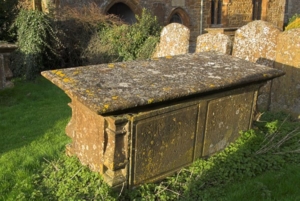 the one shown here. During the times of persecution the church would gather in the catacombs for worship and the table tombs were used as the altar for Mass. Thus the remains of the martyrs were under the altar.
the one shown here. During the times of persecution the church would gather in the catacombs for worship and the table tombs were used as the altar for Mass. Thus the remains of the martyrs were under the altar.
When they no longer had to worship in secret, the early Christians still wanted the presence of their martyrs to be near them so they opened the tombs, removed the bones and put them into jars which they then placed beneath the altar.
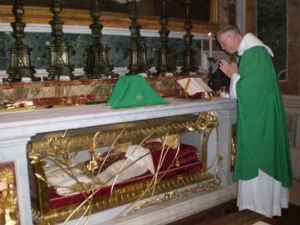 If you visit churches in Rome today you will often seen the jars with relics on display beneath the altar. More than that, you will often see the whole body of the saint on display beneath the altar. Here, for example is the altar beneath which is the relic of Pope St John XXIII
If you visit churches in Rome today you will often seen the jars with relics on display beneath the altar. More than that, you will often see the whole body of the saint on display beneath the altar. Here, for example is the altar beneath which is the relic of Pope St John XXIII
Furthermore, this tradition was so well established that not only the altar, but whole churches would be built over the tomb of the saint. Thus St Peter’s Basilica and St Paul’s Outside the Walls are both built over the tombs of the two great pillars of the church-St Peter and St Paul.
I experienced this tradition first hand when I celebrated Mass in St Peter’s in 2014. I wrote about it here. The altar at which I celebrated was the altar of SS Processus and Martinian. They were jailers of St Peter who were converted and later martyred. This picture shows me 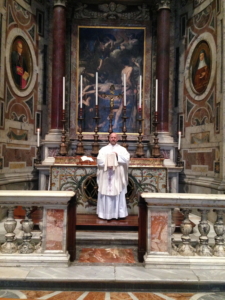
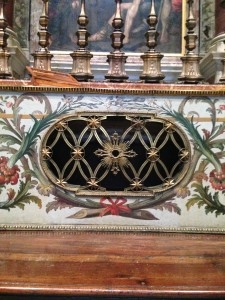 standing at the altar and the second picture is a close up of the screen at the front of the altar, behind which you can see a jar which contains the bones of the two saints.
standing at the altar and the second picture is a close up of the screen at the front of the altar, behind which you can see a jar which contains the bones of the two saints.
Is Catholicism the true Bible Christianity?
You bet.
If you found this post interesting you are going to love my new book The Mystery of the Magi-the Quest to Identify the Three Wise Men.
In this book I have cut back all the accumulated legends about the wise men and returned to the gospel of Matthew’s simple account–gathered the historical data and used the latest technology and research to unlock the secret of who the Magi were and where they came from and why.
It makes a great Christmas gift–especially for those who think the gospels are a collection of fables and fairy tales. Go here to learn more.


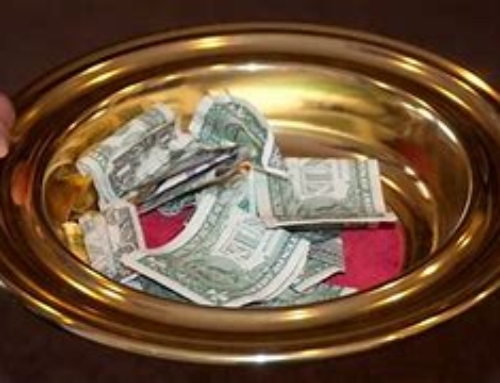


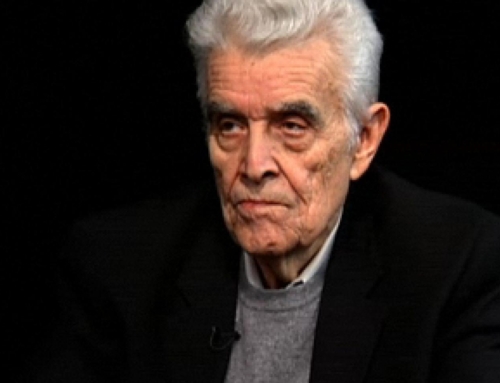
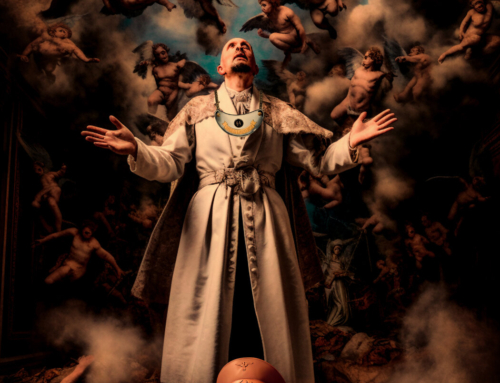
I just keep learning. Thank you!
[…] . . Tests Show Jesus’s Tomb Date Back to Ancient Roman Era – Matthew Archbold, CMR Relics in the Altar: Where is That in the Bible? – Fr. Dwight Longenecker Tolkien, Lewis, and Weapons of Mass Destruction – Joseph […]